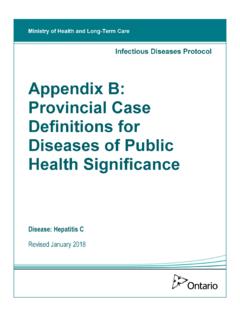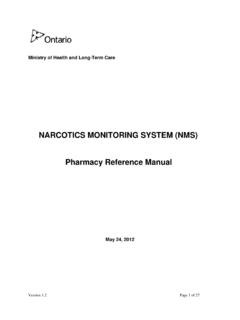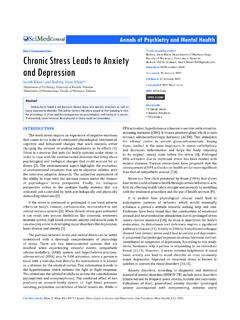Transcription of Preventing and Managing Chronic Disease: Ontario’s …
1 Preventing and Managing Chronic disease : Ontario's Framework "This document has been developed to inform planning for Chronic disease prevention and management (CDPM) in Ontario. It provides the evidence base for Ontario's CDPM Framework, which has evolved from the Chronic Care Model developed at the MacColl Institute of Healthcare Innovation, ; and been informed by the Expanded Chronic Care Model from British Columbia, that incorporates the "Ottawa Charter of Health Promotion". Ministry of Health and Long-Term Care May 2007. Preventing AND Managing Chronic disease . ONTARIO'S FRAMEWORK. SECTION I: INTRODUCTION ..3. THE IMPORTANCE OF Chronic disease .
2 3. Chronic disease CAN BE PREVENTED, DETECTED AND MANAGED .. 4. A NEW APPROACH TO Chronic disease .. 6. SECTION 2: ONTARIO'S NEW APPROACH TO Chronic CARE -- THE CDPM. FRAMEWORK 8. THE ONTARIO FRAMEWORK: IMPROVED OUTCOMES AND REDUCED HEALTH CARE COSTS .. 11. HEALTH CARE ORGANIZATIONS .. 12. PERSONAL SKILLS AND SELF-MANAGEMENT 14. DELIVERY SYSTEM DESIGN .. 18. PROVIDER DECISION SUPPORT .. 23. INFORMATION SYSTEMS .. 27. HEALTHY PUBLIC POLICY .. 30. SUPPORTIVE ENVIRONMENTS .. 32. COMMUNITY ACTION .. 35. SUMMARY 38. APPENDICES 40. APPENDIX1: THE Chronic CARE MODEL .. 41. APPENDIX 2: EXPANDED Chronic CARE MODEL .. 42. APPENDIX 3: OTTAWA CHARTER FOR HEALTH 43.
3 ACKNOWLEDGEMENTS ..44. REFERENCES 46. 2. Preventing AND Managing Chronic disease . ONTARIO'S FRAMEWORK. Section I: INTRODUCTION. The Importance of Chronic disease Chronic diseases are long-term diseases that develop slowly over time, often progressing in severity, and can often be controlled, but rarely cured. They include conditions such as cardiovascular diseases (heart disease and stroke), cancer, diabetes, arthritis, back problems, asthma, and Chronic depression. Chronic diseases may significantly impair everyday physical and mental functions and reduce one's ability to perform activities of daily living. Worldwide, Chronic diseases have overtaken infectious diseases as the leading cause of death and disability.
4 Non-communicable diseases now account for 59%. of the world's 57 million annual deaths, and 46% of the global burden of disease . The picture for Ontario is similar. In 2003, heart disease was the leading cause of death in the province and myocardial infarction the largest single cause of death within heart disease followed by cancers, stroke, and Chronic obstructive pulmonary disease (COPD). Chronic disease is most frequent among older Ontarians, since Chronic diseases can take decades to develop. In 2003, almost 80% of those over the age of 45. or million people were living with a Chronic condition, including 34% with arthritis, 9% with diabetes, 30% with high blood pressure, and 12% with osteoporosis.
5 Chronically ill Ontarians are also likely to have more than one Chronic disease . In 2003, 70 percent of chronically ill Ontarians over the age of 45 had multiple The high levels of co-morbidity reflect the fact that, untreated, a serious Chronic condition tends to lead to additional conditions and other health problems. Ontarians with diabetes account, for example, for 32% of heart attacks, 43% of heart failures, 30% of strokes, 51% of new dialysis, and 70% of amputations in the Statistics Canada estimates that major Chronic diseases and injuries account for over 33% of direct health care In Ontario, Chronic diseases account for 55% of direct and indirect health costs, which includes years of healthy life lost from premature death and lost productivity from disability as well as direct health 3.
6 Care 4 Moreover, Ontarians with multiple serious Chronic conditions consume disproportionately more health care than others with Chronic conditions . Death rates, and in some cases, prevalence rates (diagnosed cases in the population), have been declining for some Chronic diseases but increasing for others in recent years. A decline in death rates (crude rates, 1995 to 1999) has been seen for breast cancer (12%) and asthma (8%) while an increase has been seen for lung cancer (5%).5 The prevalence of cancers fell by (5%) in 2003 from 2001, but the prevalence increased for COPD (11%), arthritis (4%), and type 2. diabetes (7%) - mainly because people are living Hospitalizations for cardiovascular diseases are predicted to continue to decrease and, while some risk factors for this group of diseases are falling ( , hypertension), others are rising ( , obesity, aging).
7 The health care costs of diabetes and associated conditions are estimated to rise by as much as 48% over the next Chronic disease can be Prevented, Detected and Managed Although Chronic diseases are among the most common and costly health problems facing Canadians, they are also among the most preventable. Major Chronic diseases such as cardiovascular disease (heart disease and stroke), diabetes, arthritis, asthma, and osteoporosis share common risk factors and conditions . A small group of modifiable behaviours and intermediate biological factors/risk conditions ( , physical inactivity, unhealthy diet, tobacco, alcohol, hypertension, high cholesterol, and being overweight) account for a substantial proportion of Chronic disease (see Figure 1).
8 These modifiable factors are influenced and shaped by societal, economic and physical conditions . Changing health behaviors and biological factors have the potential to reduce Chronic disease in Ontario significantly. For example: A tobacco-free society would prevent more than 90% of lung cancer deaths and 30% of all other cancer With healthy eating, regular exercise, and not smoking, up to 90% of type 2. diabetes, 80% of coronary heart disease , and one-third of cancers can be Interventions to reduce risk factors and prevent Chronic disease can be extremely successful. One compelling example is the comprehensive community-based program in North Karelia, Finland, that brought cardiovascular disease and lung cancer rates in the region into line with national levels by reducing smoking rates, blood pressure, and cholesterol rates in the population through a broad mix of social and medical initiatives.
9 4. Figure 1: Detecting Chronic disease early, and intervening quickly to prevent its progress, also has significant potential to reduce deaths from Chronic disease . For example: If 70% of women between the ages of 50 and 69 underwent mammography screening, there would be about one-third fewer breast cancer deaths over a ten-year If Ontarians 50-75 received regular colorectal screening by fecal occult blood testing, more would receive early treatment and deaths from colorectal cancer could drop by 15-33%.11. With the right treatment and support, people diagnosed with a Chronic disease can improve their health and quality of life. Management typically involves multi- 5.
10 Faceted interventions providing integrated social and medical support for people with Chronic For example: People with diabetes who attended an interdisciplinary, community-based self-care clinic experienced an average 14% drop in blood glucose levels within one Individuals who participated in a congestive heart failure discharge program that coordinated care and provided education for them and their families had over 60% fewer readmissions to Post-fracture patients were three times more likely to have bone density testing and four times more likely to be prescribed treatment for osteoporosis when they were provided with information and telephone counseling and their physicians were provided with treatment Children and adults whose asthma care was managed by a primary care team using decisions supports and

















